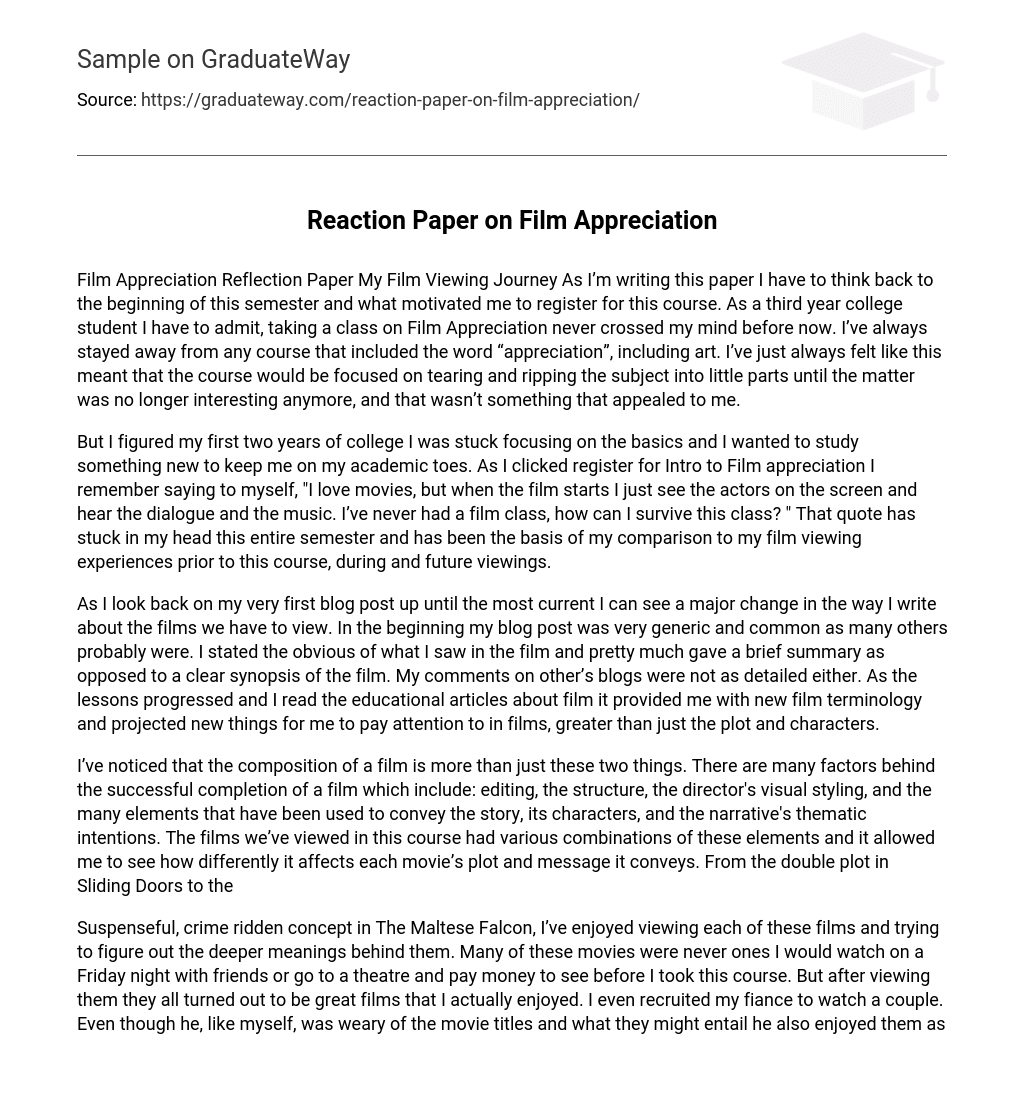Film Appreciation Reflection Paper My Film Viewing Journey As I’m writing this paper I have to think back to the beginning of this semester and what motivated me to register for this course. As a third year college student I have to admit, taking a class on Film Appreciation never crossed my mind before now. I’ve always stayed away from any course that included the word “appreciation”, including art. I’ve just always felt like this meant that the course would be focused on tearing and ripping the subject into little parts until the matter was no longer interesting anymore, and that wasn’t something that appealed to me.
But I figured my first two years of college I was stuck focusing on the basics and I wanted to study something new to keep me on my academic toes. As I clicked register for Intro to Film appreciation I remember saying to myself, “I love movies, but when the film starts I just see the actors on the screen and hear the dialogue and the music. I’ve never had a film class, how can I survive this class? ” That quote has stuck in my head this entire semester and has been the basis of my comparison to my film viewing experiences prior to this course, during and future viewings.
As I look back on my very first blog post up until the most current I can see a major change in the way I write about the films we have to view. In the beginning my blog post was very generic and common as many others probably were. I stated the obvious of what I saw in the film and pretty much gave a brief summary as opposed to a clear synopsis of the film. My comments on other’s blogs were not as detailed either. As the lessons progressed and I read the educational articles about film it provided me with new film terminology and projected new things for me to pay attention to in films, greater than just the plot and characters.
I’ve noticed that the composition of a film is more than just these two things. There are many factors behind the successful completion of a film which include: editing, the structure, the director’s visual styling, and the many elements that have been used to convey the story, its characters, and the narrative’s thematic intentions. The films we’ve viewed in this course had various combinations of these elements and it allowed me to see how differently it affects each movie’s plot and message it conveys. From the double plot in Sliding Doors to the
Suspenseful, crime ridden concept in The Maltese Falcon, I’ve enjoyed viewing each of these films and trying to figure out the deeper meanings behind them. Many of these movies were never ones I would watch on a Friday night with friends or go to a theatre and pay money to see before I took this course. But after viewing them they all turned out to be great films that I actually enjoyed. I even recruited my fiance to watch a couple. Even though he, like myself, was weary of the movie titles and what they might entail he also enjoyed them as well.
By no means necessary am I claiming to be some famed film critic or viewing expert now, but I have gained a lot of valuable knowledge from my short time in this course and it has affected the way I watch films. I can no longer just sit down and view a film “for what it is”, I’m always going to try to find some deeper meaning to it and try to figure out why certain things where shot the way they were in the film and how that feeds into the overall quality of the film. For example, last weekend one of my favorite director’s released his new film based on a critically acclaimed play named For Colored Girls.
Of course my initial reasoning behind going to view the film was 1. My favorite director produced it and 2. I enjoy films about African American culture/society. Going in to the theatre I was expecting a film that was going to make me laugh and give me something to relate to in my everyday life, but as the movie progressed I noticed so much more being delivered in the film’s concept. By the time the movie ended I had laughed, cried, became angry, sympathetic and happy all in one sitting. The film was not your typical comedy/drama it portrayed a bigger message of the ongoing problems in the African American society.
It explored what it means to be a woman of color – and a woman of any color – in this world. In lyrical, honest, angry, funny and tender language, the film’s “colored girls” evoked the feelings woven into the fabric of black female life in America. I left the theatre, neither laughing nor complex but more socially conscience. I still will be drawn to African American comedies/dramas, action and suspense movies, but I think taking this course will have me viewing films in hopes to obtain more than just a laugh or scare. I’m going to seek out a deeper meaning and want to understand every aspect of the film.





